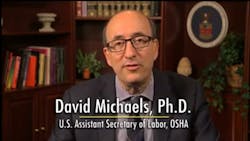Saying that the “most serious hazards are the silent killers, the ones we can’t see,” Dr. David Michaels today announced that OSHA is launching what he called “a national dialogue” with stakeholders to manage worker exposure to hazardous chemicals in the workplace.
The first stage of this dialogue is a request for information on the management of hazardous chemical exposures in the workplace and strategies for updating permissible exposure limits.
“Thousands of workers still are becoming ill and dying as a result of exposure to hazardous chemical,” said Michaels, adding that workers are being “exposed to levels of chemicals that are legal, but not safe.”
OSHA’s PELs, which are regulatory limits on the amount or concentration of a substance in the air, are intended to protect workers against the adverse health effects of exposure to hazardous substances. Ninety-five percent of OSHA’s current PELs, which cover fewer than 500 chemicals, have not been updated since their adoption in 1971.
Michaels pointed out that OSHA’s current PELs cover only a small fraction of the tens of thousands of chemicals used in American workplaces. “New chemicals are introduced into the workplace every year and we’re struggling to keep up,” he admitted.
Substantial resources – including expensive economic and technical feasibility studies that often take years to complete – are required to issue new exposure limits or update existing workplace exposure limits, as courts have required complex analyses for each proposed PEL.
As a result, “Many of our chemical exposure standards are dangerously out of date and do not adequately protect workers,” said Michaels, who noted that only 30 PELs out of the more than 500 that exist have been updated. “While we will continue to work on updating our workplace exposure limits, we are asking public health experts, chemical manufacturers, employers, unions and others committed to preventing workplace illnesses to help us identify new approaches to address chemical hazards.”
Some of these new approaches for which OSHA is seeking public comment include:
- Streamlined approaches for risk assessment and feasibility analyses.
- Alternative approaches for managing chemical exposures, including control banding, task-based approaches and informed substitution. Control banding is a technique used to guide the assessment and management of workplace risks. It is a generic technique that determines a control measure based on a range or “band” of hazards and exposures, as defined by the National Institute of Occupational Safety and Health (NIOSH).
The goal of the public dialogue is to give stakeholders a forum to develop innovative, effective approaches to improve the health of workers in the United States. In the coming months, OSHA will announce additional ways for members of the public to participate in the conversation.
The comment period for the RFI will continue for 180 days. Instructions for submitting comments are available in the Federal Register, Docket No. OSHA-2012-0023. For more information, visit the OSHA Chemical Management Request for Information Web page.
One stakeholder group, the American Industrial Hygiene Association (AIHA), already has come out in support of OSHA's efforts. “Updating the PELs has been, and remains, the number one public policy issue for our members,” said AIHA President-elect Daniel H. Anna, PhD, CIH, CSP. “The publication of this RFI marks a step forward for AIHA and other stakeholders who have long pushed for this update. We will continue to do everything possible to see that the problem of outdated PELs is addressed by OSHA and the federal government.”
AIHA said the RFI "is one of several recent signs that OSHA is serious about bringing the issue of outdated PELs back to the table."
In May 2012, the Federal Advisory Council on Occupational Safety and Health recommended that the Department of Labor consider asking the president to update OSHA’s PELs by executive order. In October 2013, OSHA created a toolkit to assist employers and workers in identifying and substituting safer chemicals to use in place of more hazardous ones, and developed an Annotated Occupational Exposure Limits table that provides accurate and up-to-date chemical information to employers who want to voluntarily adopt newer, more protective workplace exposure limits for those chemicals that are covered by outdated OSHA exposure standards.
About the Author

Sandy Smith
Sandy Smith is the former content director of EHS Today, and is currently the EHSQ content & community lead at Intelex Technologies Inc. She has written about occupational safety and health and environmental issues since 1990.
